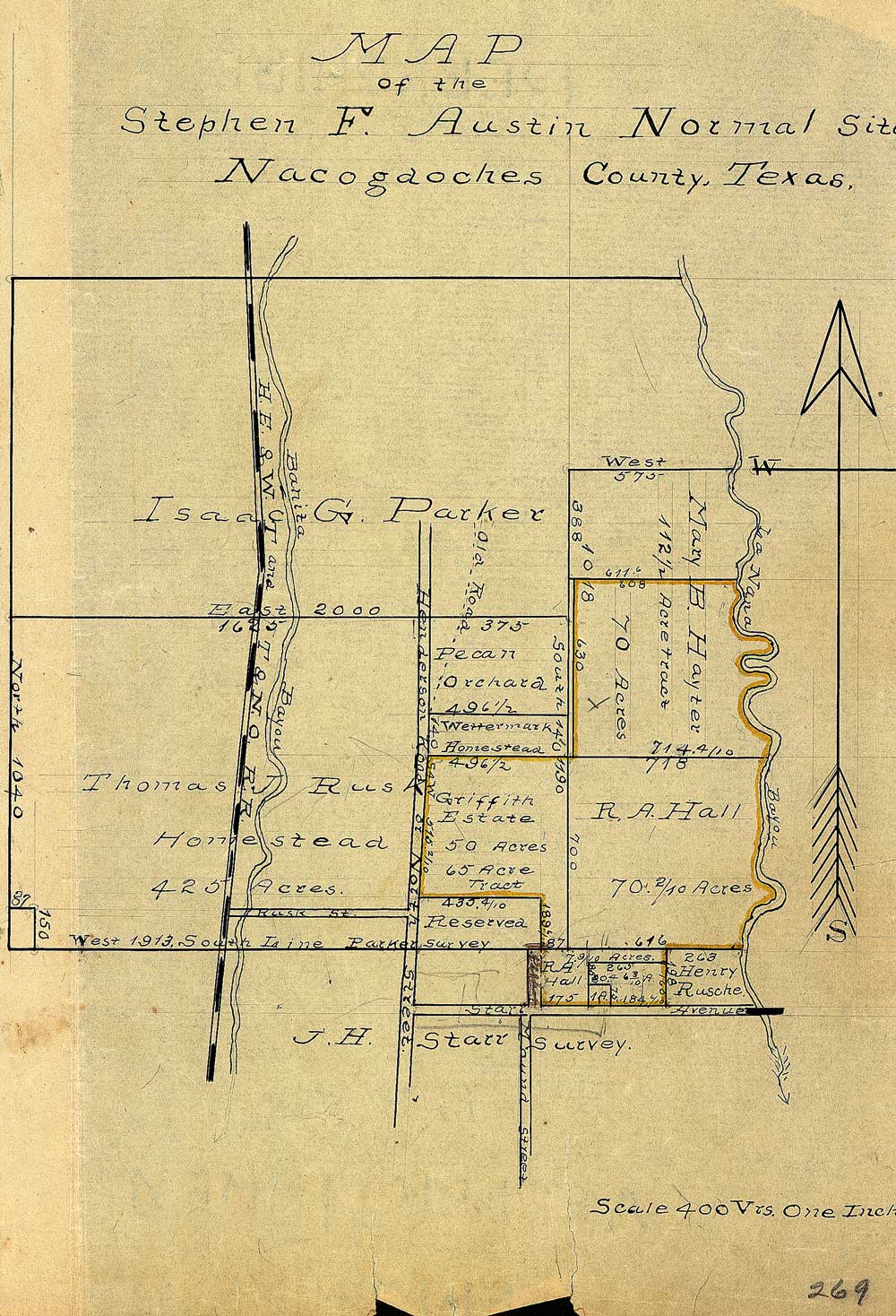Abstract of property historically interesting
The abstract of the property on which SFA sits is a most interesting document. There were six separate tracts of land which made up the original 208 acres. The title for the land was transferred to the state on September 6, 1917, but it was not declared to be free of problems until after the State Attorney General's office certified it. This process took several years. In the meantime, the trustees who held the land (I. L. Sturdevant, D. K. Cason, H.T. Mast, Eugene H. Blount, and George H. Meisenheimer) had to show tax receipts for the payment of taxes in 1917 and 1918.
The land in this northern part of the city belonged to some very historic personages. Most of the area of the campus came from the original Isaac G. Parker Survey, with a portion from a Sam Houston Survey. The bulk of the campus at one time belonged to the homestead of Thomas J. Rusk. [See Mayfields 1923 Daily Sentinel Article] Later owners included another signer of the Texas Declaration of Independence in addition to Rusk, William S.Clark. Other local luminaries include James Harper Starr, Licurgus E. Griffith, R. A. Hall, George F. Ingraham, Henry C. Hubert, R. H. Irion, B. S. Wettermark, and J. J. Hayter. Six tracts made up the original land purchased by the Nacogdoches Citizens Committee: the Mary B. Hayter 70 acres, the Rusk Homestead 50 acres (the Griffith Tract), the R. A. Hall 70 acres, the R. A. Hall Homestead 10 acres, the A. L. Tindall Homestead of 7 acres, and an additional 1 acre tract held by George F. Ingraham from the James H. Starr Survey.
The Abstract, continued...
June C. Harris, W. U. Perkins, and Charles Hoya in 1917 appeared before a notary public and swore testimony that they were acquainted with the tracts for more than thirty years and knew of no outstanding controversies pertaining to the property. There had been a controversy over a portion of the James Harper Starr property, but eventually the State Attorney General's investigation of the deeds discovered a document, signed by Houston in the presence of Thomas J. Rusk in 1855, which sold the land to Starr for $1,200.00.
For the money to purchase the land, the Citizens Committee came up with the idea of asking the citizenry to donate the amount of money they paid each year in school taxes. By this method, the Committee tapped the economic power of 890 people and amassed $14,494.96. The personal assessments ranged from $.05 cent to the $569.14 owed by Mrs. E. A. Blount. The commercial assessment for the Nacogdoches Grocery Company was $775.07; for the Frost Johnson Lumber Co. $666.64; for the H. E. & W. T. Railroad $453.10; for Commercial Bank $333.33; for Stone Fort Bank $283.28. Interviewed later, Mr. Roy Gray said: "People were glad to do it ....That was one of the few instances--Hotel Fredonia was another--in which people of Nacogdoches all stood together." (The Daily Sentinel, August 5, 1961.)
The totalpurchase price for the SFA campus was $20,050.00. The R. A. Hall acreage brought the top price of $8,000, but it included improvements of the house mentioned elsewhere; the Griffith tract went next for $6,000, not including their return gift to the city of the park land; the Hayter acreage cost $3,500. Since the tax assessment did not raise enough money for the total purchase price for all the property, a group of men had to guarantee the rest. The Commercial Bank and the Stone Fort Bank probably made up the difference; the names of I. L. Sturdevant, W. U Perkins, Charles Hoya, June C. Harris, J. R. McKinney, and H. T. Mast, are all part of the process, but exact amounts and names must await further research.
It is interesting to note, several of the men who played an important part in the acquisition and the gift of the property to the college decided to link their personal residences to the new neighborhood of the school. Senator Eugene Blount built his own new home in 1923 directly across from the entrance of the new college where he could look down the vista to watch over SFA. Nearby, on the souther part of the Rusk Homestead, bankers T. E. Baker and I. L.Sturdevant built news homes later in the 1920s. Considered almost in the country at the time, these homes are testimony to the way SFA was to change the visible heritage of Nacogdoches.
An interesting footnote. Senator Eugene Blount, in overseeing the campus land during these interium years, ran into a recurring problem, the continuation of cutting of the valuable timber on the property. Blount notified the Board of Regents and then the Attorney General "that said property was being denuded of valuable timber" and "viloated by trespassers." (Minutes, February 4, 1918) Repeated injunctions issued against "Hayter et al for depredating property conveyed to the state" were discussed in the Board Minutes until 1921. (JLJ)
